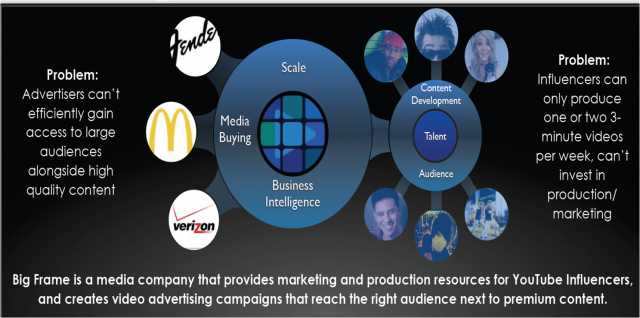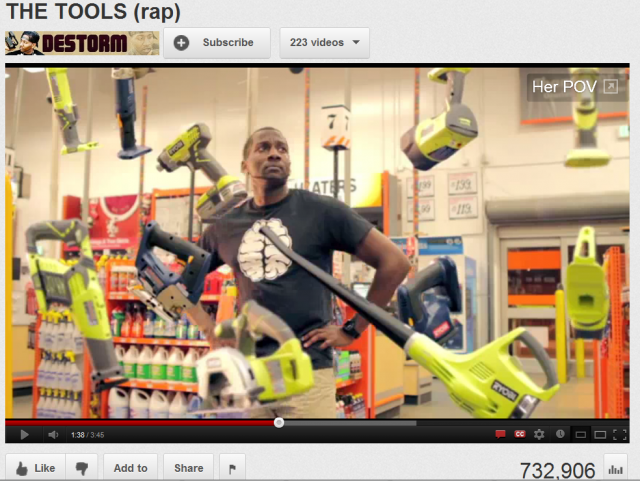 This article originally appeared on TechCrunch HERE.
This article originally appeared on TechCrunch HERE.
My son recently tried to call one of our older relatives. He dialed the number and quickly hung up with a confused look on his face. I asked him what was wrong and he replied, “I don’t know. There’s something wrong with their phone, it kept beeping.” I called the number and was amused to hear a landline busy signal, something my cell phone centric pre-teen had never encountered.
My son is similarly unacquainted with cable TV. Other than the occasional NBA game, he consumes his video content via our iPad and Xbox. Most of his online viewing is spent on YouTube. He is not alone.
Mark Suster, fellow venture capitalist and serial entrepreneur, has written extensively about YouTube’s evolution from dogs-on-skateboards to its current status as an entertainment medium rivaling cable television networks. Mark provides an excellent primer regarding the future of Internet TV HERE.
YouTube has over 800 million monthly unique visitors who consume over 4 billion videos EACH DAY. Its evolution has resulted in a new class of entertainment entrepreneur, the creators of professional YouTube content, affectionately known as YouTubers.
If you haven't already subscribed yet,
subscribe now for free weekly Infochachkie articles!
Feeding The New Networks
Running an immensely profitable business has many benefits, including the ability to jumpstart an ecosystem which directly drives revenue to one of your core offerings. During the latter half of 2011, Google awarded a number of leading YouTubers and nascent Internet TV networks grants of $1 million to $2 million. Although estimates of Google’s total investment vary, the industry insiders I spoke with believe it exceeded $100 million. Earlier this month, Google announced that it will spend an additional $200 million to promote YouTube content.
Despite the snarky rumors that Google’s content development program was poorly managed at its outset (e.g., some of the money was spent by YouTubers to purchase homes and not create videos), the majority of the funds were properly deployed by the emerging community of professional YouTubers. In fact, all of the most prominent Internet TV networks were recipients of such grants, including: Maker Studios, Big Frame, Machinima and FullScreen.
Before the creation of YouTube networks, a handful of leading YouTubers were generating over $100,000 in revenue per year, simply by running run-of-site YouTube ads. Networks have significantly increased YouTubers’ advertising revenue by negotiating sponsorships and large ad purchases with major brands.
Rather than simply act as old-world talent agencies, Internet TV networks offer their talent a number of differentiating advantages which are difficult for YouTubers to secure on their own, including:
Critical Mass – Even though some of the most successful YouTubers routinely generate several million views per video, large advertisers are challenged to spend efficiently within the medium, because even millions of views results in a relatively small advertising spend. This paradox is aptly illustrated in the following graphic, courtesy of Big Frame.
 By allowing advertisers to purchase ads across a cadre of YouTubers, Internet TV networks can achieve their efficiency and reach goals.
By allowing advertisers to purchase ads across a cadre of YouTubers, Internet TV networks can achieve their efficiency and reach goals.
Cross-promotion – The rap industry has proficiently utilized cross-promotions since its inception. For instance, over twenty years ago, Dr. Dre featured then unknown Snoop Dogg on his solo debut The Chronic, effectively launching Snoop’s career. Similar opportunities exist on YouTube, in which YouTubers with large audiences can introduce and promote up-and-coming artists. For instance, Kids React reviewed a video by DeStorm, while the Gregory Brothers incorporated Kids React into their hilarious Chuck Testa video.
 Better Content –The average YouTuber is chiefly interested in creating engaging content, not negotiating insertion orders, trafficking ads or tracking down delinquent advertiser payments. Thus, Internet TV agencies not only increase a YouTuber’s income, they also free them to focus on what they do best – create engaging content. The additional revenue generated by each video allows the YouTubers to leverage better (and more costly) special effects, which beget better quality content. Better videos engage more viewers, which attract additional advertising dollars.
Better Content –The average YouTuber is chiefly interested in creating engaging content, not negotiating insertion orders, trafficking ads or tracking down delinquent advertiser payments. Thus, Internet TV agencies not only increase a YouTuber’s income, they also free them to focus on what they do best – create engaging content. The additional revenue generated by each video allows the YouTubers to leverage better (and more costly) special effects, which beget better quality content. Better videos engage more viewers, which attract additional advertising dollars.
Subscriptions & Social Sharing – In the last century, magazine and newspaper subscriptions drove readership, which sold print ads. The same phenomenon is true in the YouTube ecosystem, but with a social media twist.
YouTube allows viewers to subscribe to their favorite channels. Each time a new video is posted by a YouTuber, its subscribers are immediately notified. Although the shareing settings are configurable by user, when most people Like or Tweet a video, the action is broadcast within their social graph.
Such YouTube subscriptions are the engine of a virtuous circle of views, which leads to social sharing, which, in turn, generates additional subscriptions. If you are a Google subscription virgin and want to better understand how the process works, you can check out my startup-oriented YouTube channel, which has previously featured interviews with folks like Guy Kawasaki, Brad Feld and Steve Blank.
Better Ads – Product placement ads have been around since the 1800’s when notable novelists, including Jules Verne, were lobbied by business people to mention their products and technologies in their books.
 The effectiveness of product placements was reduced dramatically in the mid-1990s when the practice became so overt and numerous, especially in major motion pictures, it became distracting and, in some instances, outright laughable. Learning from the mistakes of the past, YouTubers have created clever ways to embed advertising messages into entertaining content.
The effectiveness of product placements was reduced dramatically in the mid-1990s when the practice became so overt and numerous, especially in major motion pictures, it became distracting and, in some instances, outright laughable. Learning from the mistakes of the past, YouTubers have created clever ways to embed advertising messages into entertaining content.
One of the best examples of this integration is DeStorm’s November 2011 video in which he raps about Ryobi tools while running through the aisles at Home Depot. True to the cross-promotional nature of the YouTube landscape, fellow YouTuber MysteryGuitarMan makes a cameo appearance.
DeStorm delivers the Ryobi rap lyrics in an engaging and, from an advertising standpoint, informative manner:
I ain’t afraid to dismantle it,
I can handle it, ‘cause,
I got the tools.
I got the power.
Yea, I got the tools,
To change everything around me.
I can take control of everything ahead of me,
cause it’s all controlled by the same battery.
The pairing of Home Depot, Ryobi and DeStorm is effective because the relatively inexpensive tools, which use a common battery, are targeted at a subset of DeStorm’s young, male audience: young renters and first-time home buyers, many of whom are tool deficient. DeStorm is extremely talented – if you are curious, you can check out the Ryobi video HERE.
Top YouTubers
The top-five YouTubers, along with a few of my favorites, are listed below. The subscriber numbers and their relative ranking are as of mid-May 2012. I encourage you to check out each of these artists, as you may be surprised by the production values and overall entertainment quotient of their material.
| Rank | YouTuber (Show Title) | Subs (M) | Total Views |
| 1 | Ray William Johnson (Equals Three) | 5.5 | 1.8 B |
| 2 | Ryan Higa (Nigahiga) |
5.2 |
1.2 B |
| 3 | Ian Hecox & Anthony Padilla (Smosh) | 4.7 | 1.5 B |
| 5* | Freddie Wong & Brandon Laatsch (Freddiew) | 3.2 | 625M |
| 6 | Jenna Marbles (JennaMarbles) | 3.1 | 532 M |
| 15 | Joe Penna (MysteryGuitarMan) | 2.1 | 317 M |
| 31 | Peter Shukoff (nicepeter) | 1.6 | 472 M |
| 41 | Benny & Rafi Fine (Kids React, et al) | 1.4 | 275 M |
| 50 | The Gregory Brothers (schmoyo) | 1.3 | 419 M |
| 56 | DeStorm (DeStorm, DeStormTV) | 1.2 | 166 M |
* The fourth most popular YouTube video producer is Machinima. I did not include it here, as it is a Network.
Some of you may not be familiar with these YouTubers. As with any emgerging form of media, the early adopters (like my son) are young people whose viewing habits have not vulcanized around the legacy modality, cable television. Even though I am not in the 13-25 male demographic that many of the above artists speak to, I am impressed with their ability to inexpensively create engaging, short-form videos.
Climbing A Mountain With No Hands
I recently spoke with a talented gaming executive who noted that creating a top-ten mobile game is akin to trying to, “climb a mountain with no hands.” It can be done, but it is a grueling process.
However, once you create a hit game, it is much easier to replicate the initial game’s success by launching related titles. The same phenomenon is true in the YouTube ecosystem. With a little help from Google, and a lot of hard work, today’s leading Internet TV networks have reached the summit and are in the process of launching new YouTubers who will benefit from the networks’ high-velocity virtuous circles.
Google’s continued oversight and backing, combined with professionalized content and ongoing ad optimization, will ensure that Internet TV will eventually eclipse its legacy brethren, allowing you to store your cable television in your garage, right next to your landline phone. Soon cable TV will be a distant memory, much like a landline telephone’s busy signal.
Follow my startup-oriented Twitter feed here: @johngreathouse. I promise I will never Tweet about celebrities, cable TV shows or that killer burrito I just ate.



